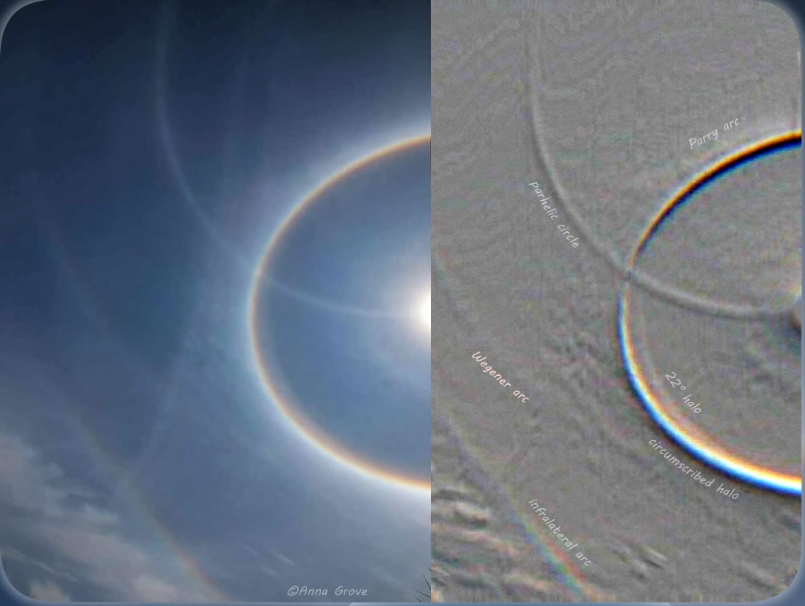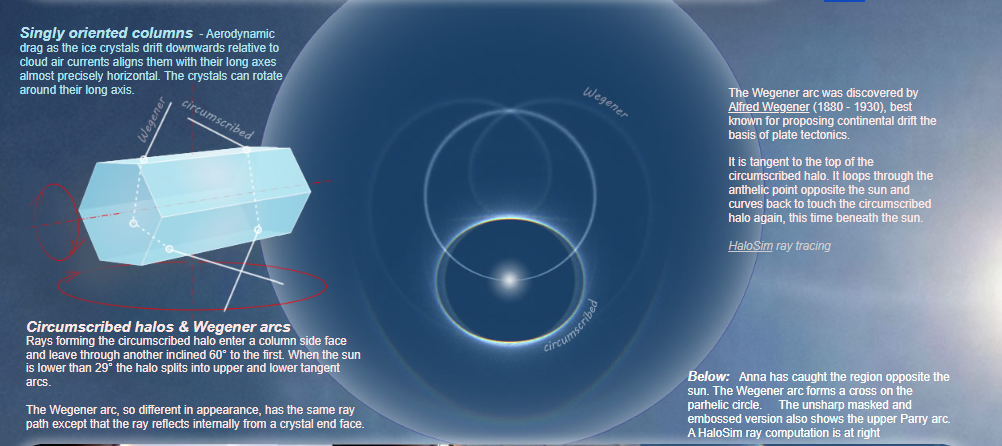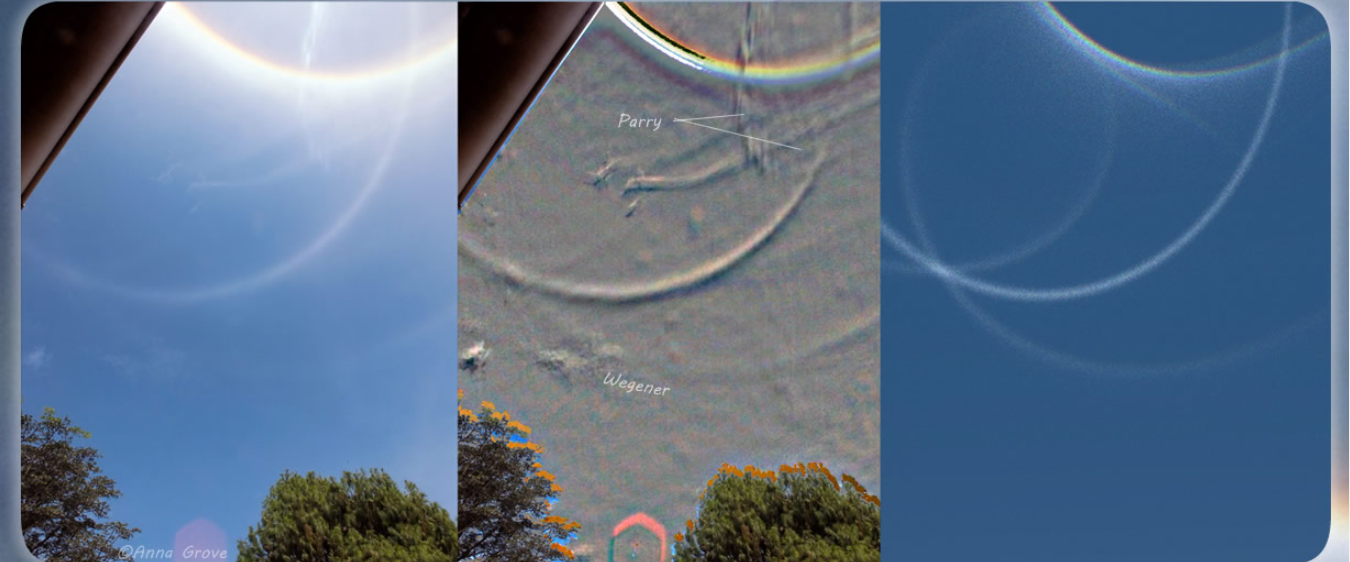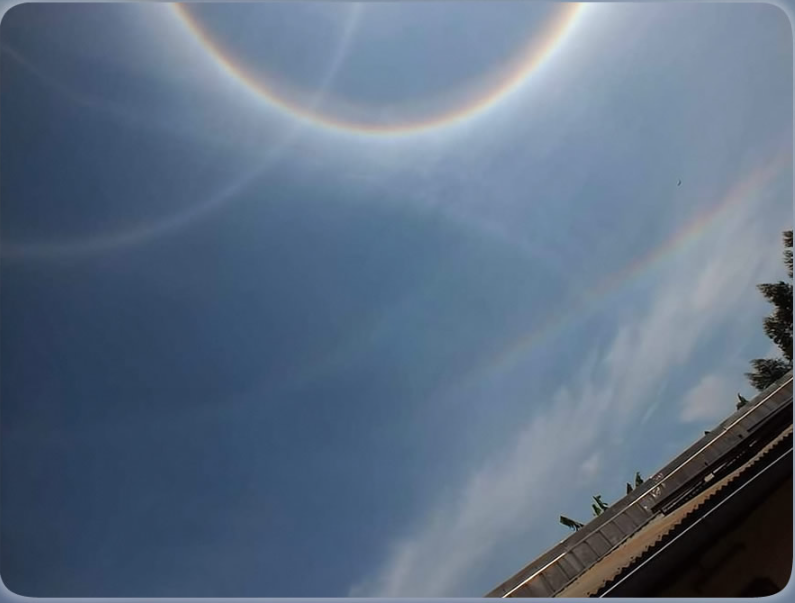Africa High Sun Wegener & Parry Arcs - OPOD
Africa High Sun Wegener & Parry Arcs - OPOD: Exploring the Enigmatic Atmospheric Optics Phenomena
Have you ever witnessed the captivating dance of light in the African sky? In Cameroon, West Africa, on September 8, 2013, Anna Grove captured a mesmerizing display of halos. These atmospheric optics phenomena, occurring under a high sun, showcased the intricate interplay of ice crystals and sunlight. Let's delve into the details of these extraordinary occurrences that left spectators in awe.
Unveiling the African Halos
Anna Grove's photographs revealed a fascinating array of halos above Cameroon. At the heart of this spectacle was a circular 22° halo, created by randomly oriented hexagonal prisms. However, it was the precisely aligned horizontal column crystals that dominated the scene. These crystals produced an intense circumscribed halo encircling the sun and a white parhelic circle crossing it. Additionally, they gave rise to an infralateral arc, a colored arc near the horizon.
The Elusive Wegener Arc
One of the most remarkable features of this atmospheric display was the faint Wegener arc. Curving across the sky from beneath the sun, this arc owed its existence to the horizontal columns once again. The Wegener arc, named after Alfred Wegener, who proposed continental drift and laid the foundation for plate tectonics, followed a distinctive path. It touched the top of the circumscribed halo, looped through the anthelic point opposite the sun, and curved back to meet the circumscribed halo beneath the sun.
The Enigmatic Parry Arc
Another rarity observed during this event was the high sun Parry arc. This arc, originating from horizontal columns with two side faces aligned horizontally, added to the mystique of the atmospheric optics display. The Parry arc appeared alongside the Wegener arc, both contributing to the captivating visual symphony in the sky.
Insights into Crystal Orientation
To understand the formation of these arcs, it is crucial to examine the orientation of the ice crystals involved. The crystals responsible for the Wegener and Parry arcs are singly oriented columns. As these crystals drift downwards relative to the air currents within the cloud, aerodynamic drag aligns their long axes almost perfectly horizontally. Furthermore, these crystals can rotate around their long axis, adding an element of dynamism to their alignment.
HaloSim Ray Tracing: Unveiling the Secrets
To shed light on the intricacies of the circumscribed halos, Wegener arcs, and Parry arcs, researchers employ HaloSim ray tracing simulations. These simulations provide valuable insights into the path of rays and how they interact with ice crystals to produce these atmospheric phenomena. Rays forming the circumscribed halo enter a column side face and exit through another inclined face at an angle of 60° to the first. When the sun is lower than 29°, the halo splits into upper and lower tangent arcs.
Decoding the Colored Arcs
One of the intriguing aspects of this atmospheric display was a lower colored arc, which could potentially be a circumhorizon arc from plate crystals. However, given its upward curvature towards the Wegener arc and the presence of high concentrations of column crystals, it is more likely an infralateral arc. These enchanting arcs add depth and complexity to an already mesmerizing spectacle.
Appreciation and Gratitude
We extend our gratitude to Alan Clark of Alberta, Canada, for bringing this captivating display to our attention and engaging in numerous insightful discussions. His contributions have helped shed light on the intricacies of these atmospheric optics phenomena.
As we reflect on the African High Sun Wegener & Parry Arcs, we gain a deeper appreciation for the wonders of our atmosphere. These fleeting moments of ethereal beauty remind us of the intricate interplay between light and matter, inviting us to explore the mysteries that lie above us.

African Halos
Anna Grove photographed these halos on September 8, 2013 in Cameroon, West Africa.
The innermost ice crystal halo is a weak circular 22° halo from randomly oriented hexagonal prisms.
Quite precisely aligned horizontal column crystals dominate the rest of the display. They made the intense circumscribed halo. Reflections from their hexagonal end faces generated the white parhelic circle crossing the sun. They also made the coloured arc near to the horizon – an infralateral arc.
A particularly unusual feature is the faint Wegener arc (horizontal columns again!) curving out across the sky from beneath the sun.
Another rarity is the high sun Parry arc, this from horizontal columns with two side faces also aligned horizontal.
Images ©Anna Grove, shown with permission

Singly oriented columns - Aerodynamic drag as the ice crystals drift downwards relative to cloud air currents aligns them with their long axes almost precisely horizontal. The crystals can rotate around their long axis.
The Wegener arc was discovered by Alfred Wegener (1880 - 1930), best known for proposing continental drift the basis of plate tectonics.
It is tangent to the top of the circumscribed halo. It loops through the anthelic point opposite the sun and curves back to touch the circumscribed halo again, this time beneath the sun.
HaloSim ray tracing
Circumscribed halos & Wegener arcs
Rays forming the circumscribed halo enter a column side face and leave through another inclined 60° to the first. When the sun is lower than 29° the halo splits into upper and lower tangent arcs.
The Wegener arc, so different in appearance, has the same ray path except that the ray reflects internally from a crystal end face.
Below: Anna has caught the region opposite the sun. The Wegener arc forms a cross on the parhelic circle. The unsharp masked and embossed version also shows the upper Parry arc. A HaloSim ray computation is at right

The lower coloured arc could be a circumhorizon arc from plate crystals rather than an infralateral.
However, given that it appears to curve upwards to the Wegener arc and that high concentrations of column crystals are present, an infralateral arc is more probable.

A big thank you to Alan Clark of Alberta, Canada for bringing this display to OPOD and for many helpful discussions.
Note: this article has been automatically converted from the old site and may not appear as intended. You can find the original article here.
Reference Atmospheric Optics
If you use any of the definitions, information, or data presented on Atmospheric Optics, please copy the link or reference below to properly credit us as the reference source. Thank you!
-
<a href="https://atoptics.co.uk/blog/africa-high-sun-wegener-parry-arcs-opod/">Africa High Sun Wegener & Parry Arcs - OPOD</a>
-
"Africa High Sun Wegener & Parry Arcs - OPOD". Atmospheric Optics. Accessed on April 18, 2024. https://atoptics.co.uk/blog/africa-high-sun-wegener-parry-arcs-opod/.
-
"Africa High Sun Wegener & Parry Arcs - OPOD". Atmospheric Optics, https://atoptics.co.uk/blog/africa-high-sun-wegener-parry-arcs-opod/. Accessed 18 April, 2024
-
Africa High Sun Wegener & Parry Arcs - OPOD. Atmospheric Optics. Retrieved from https://atoptics.co.uk/blog/africa-high-sun-wegener-parry-arcs-opod/.